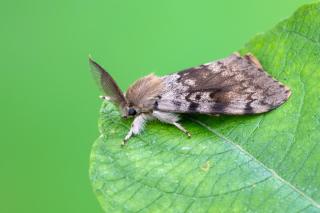Lymantria Dispar Outbreak in Pennsylvania

If you have been out in the woods of Rothrock here in Centre County or many other places around the state, you know that Pennsylvania is currently experiencing an outbreak of Lymantria dispar, sometimes referred to as "gypsy moth". This moth is a serious forest pest and, in combination with repeated defoliation events or other tree stressors such as drought, has been responsible for killing millions of oak and other species of trees in the past. Although oak species are preferred, these moth caterpillars feed on hundreds of other tree and shrub species, including both deciduous and evergreen species.
Fuzzy, felt-like, tan egg masses laid by females during the prior adult mating season contain hundreds of eggs per mass and are often found attached to tree trunks, in sheltered branch locations, and on many other outdoor structures. Larvae hatch from early April to late May, usually climbing the same tree where their egg mass is located to feed or blowing on silk strands to neighboring stands of trees. Caterpillars feed on foliage and molt several times as they mature. Mature caterpillars, what we mostly are seeing around town, are distinctive in appearance, with five pairs of blue spots and six pairs of red spots running down the body.
Many landowners and homeowners are worried about what these insects are doing to their trees. With the current size of caterpillars in our area, the defoliation is readily apparent. Unfortunately, we are at a stage in the life cycle where there is not much to be done – any treatment, other than mechanical removal, is going to kill off beneficial insects, and not help the trees.
Fortunately, as long as there are no other additional stressors, most trees can handle a year of defoliation. However, refoliation can use many of its resources and make the tree susceptible to stressors in the future. If conifers are attacked and their needles are completely lost, the conifers will not re-leaf and will die.
Currently, we are waiting to see what the effect of these insects will have on our tree canopy. We may see a bigger outbreak next year based on the growing population of lymantria dispar.
We hope for a cool wet spring next year to help a fungal pathogen or virus decrease the population. We are starting to see some effect of these biocontrols – perhaps they will decimate the population before they pupate into adults.
For great summary articles including information about what to do now as homeowners or landowners and what to plan for in the future, check out this article from Penn State Extension and this article from the Pennsylvania Department of Conservation and Natural Resources Bureau of Forestry.
If you have questions, please reach out to the Township Arborist at 814-238-4651.

